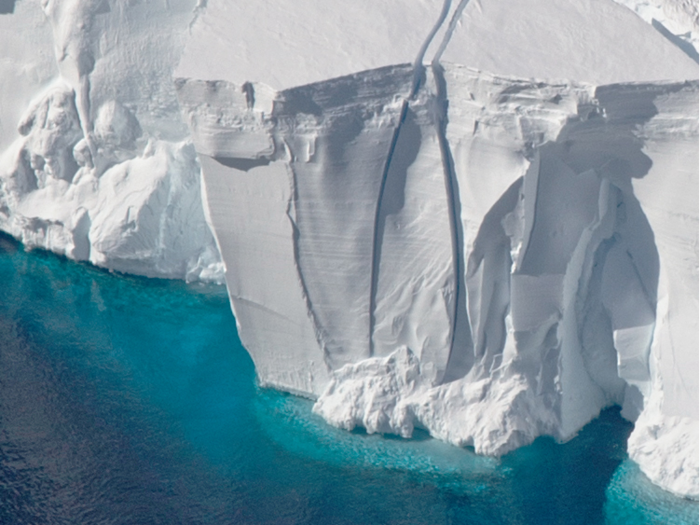
Thwaites Glacier is a large mass of ice born from snow that's been compressed over time. It's part of the Antarctic ice sheet — a large continental glacier that covers at least 20,000 square miles of land.
The Thwaites Glacier's floating ice shelf extends outward into the Amundsen Sea. Such shelves are characteristically flat and form a physical barrier around the continental ice, which slows ice sheets' movement and melting. Without them, sea-levels would rise faster.

The more a glacier's undercarriage is exposed to the warming ocean waters, the more likely it is to see accelerated melting.
The recently discovered cavity is large enough to have held 14 billions tons of ice. Millilo and his study co-authors think most of that ice melted in the past three years.

“It’s a direct impact of climate change on the glacier,” Rignot added.

The new study suggests that scientists have a lot more to learn about the impact of warming oceans on ice shelves.
"The cavity is not the main target of my research," Milillo told Business Insider. "What is surprising about the cavity is that it means ocean-ice interactions are more complex than we previously understood. This is the new message here."

The agency's Operation IceBridge project, which began in 2010, flies over the North and South Poles each year to collect data via airborne instruments and observations. Its findings supplement NASA's satellite data, and allow scientists to analyze different glaciers' heights and melting speeds.

To understand a glacier's grounding line, think of a spit of land that extends past a cliff's edge into the air — it's the same concept with glaciers, except instead of air, the ice is floating on water.
Many of Antarctica's glaciers extend far beyond their grounding lines into the ocean, sometimes for miles, according to NASA. But as global temperatures rise (and oceans absorb much of that heat), glaciers' grounding lines are moving inland, leaving more ice floating on water.
Thwaites's grounding line moved almost 9 miles inward between 1992 and 2011, according to a 2014 study.
Floating glaciers are less stable, since they're prone to calving events in which parts of the glacier fall into the ocean. Glaciers on water also melt faster than ice on land does.

Antarctica’s ice sheet could cover the surface area of the United States and Mexico combined, according to Columbia University's Earth Institute.
If the whole Thwaites Glacier melted, it would result in a worldwide sea-level rise of more than 2 feet. What's more, Thwaites prevents its neighbor glaciers from flowing into the oceans, too. If one goes, they could all go — and that chain-reaction would raise sea levels an additional 8 feet.

Because this region's glaciers have grounding lines that are below sea level, it's easier for the ocean to pound those lines with warm water, according to NASA.
Milillo said the glaciers seem to be responding to what's happening in the ocean in disproportionate ways.
"That’s why it's difficult to predict, and why new need satellites to capture the tiniest changes in the glaciers," he said.

The amount of ice this part of Antarctica has lost to the ocean has increased by 77% since 1973, one of Rignot's other studies showed. Half of that increase happened between 2003 and 2009.
That increased quantity of ice floating out to sea, coupled with accelerated melting, are indicators of an eventual collapse. Unless something changes, the Thwaites Glacier is on pace to collapse in as little as 100 to 200 years from now, according to NASA's Earth Observatory.
"How fast will this happen is the most important question in glaciology," Milillo said. "We're trying to understand the timescale of this thing."
 I quit McKinsey after 1.5 years. I was making over $200k but my mental health was shattered.
I quit McKinsey after 1.5 years. I was making over $200k but my mental health was shattered. Some Tesla factory workers realized they were laid off when security scanned their badges and sent them back on shuttles, sources say
Some Tesla factory workers realized they were laid off when security scanned their badges and sent them back on shuttles, sources say I tutor the children of some of Dubai's richest people. One of them paid me $3,000 to do his homework.
I tutor the children of some of Dubai's richest people. One of them paid me $3,000 to do his homework. Why are so many elite coaches moving to Western countries?
Why are so many elite coaches moving to Western countries?
 Global GDP to face a 19% decline by 2050 due to climate change, study projects
Global GDP to face a 19% decline by 2050 due to climate change, study projects
 5 things to keep in mind before taking a personal loan
5 things to keep in mind before taking a personal loan

Copyright © 2024. Times Internet Limited. All rights reserved.For reprint rights. Times Syndication Service.